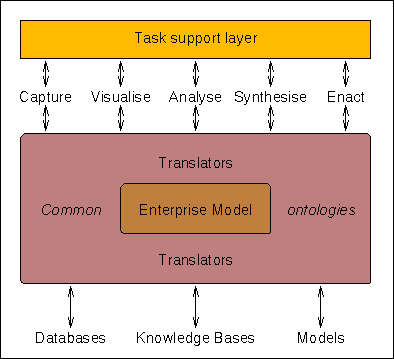
One of the main deliverables of the Enterprise project will be a computer toolset which will help capture aspects of a business and analyse these to identify and compare options for meeting the business requirements. A high-level view of the toolset, showing how ontologies are used to support the enterprise model, is shown in figure 1.

Figure 1: High Level View of the Enterprise Toolset
Ontologies define the commonly accepted world views in which enterprise models are built. The information in the models is typically distributed through various repositories (databases, knowledge bases and models of other kinds) whose vocabularies may differ from the ontologies. Thus translators are needed to map information into and out of the terms of the ontologies. Information necessarily gets lost in some of the translations and it is an open question whether this loss of information is in general serious enough to throw the use of ontologies into doubt.
Similarly, translators may be needed to allow users to carry out the tasks described in Users and Modes of Use. (For example, a standard analysis report may require figures for staff turnover, while the ontologies define terms only for employee, contract, begin and end: a conversion is needed between these terms and the one required for the report.)
A task support layer helps the user understand and execute the activities required for a particular task, for instance the formulation of a strategic plan or of a business case.
Figure 1: High Level View of the Enterprise Toolset